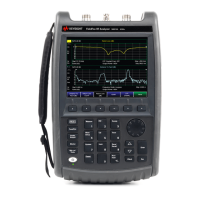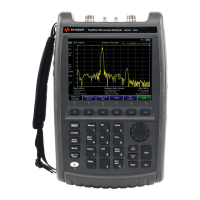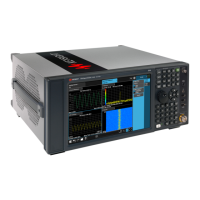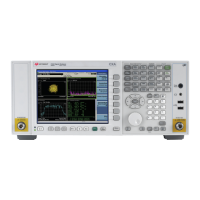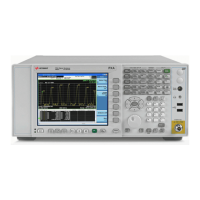Keysight N9927-90001 User’s Guide 97
NA (Network Analyzer) Mode
NA Mode Settings
—Then enter a positive or negative offset value in dB using the numeric
keypad, the arrows, or the rotary knob. Press a multiplier key.
Learn about multiplier abbreviations.
—And/or press Slope
- Offsets the data trace by a value that changes linearly
with frequency. The offset slope begins at 0 Hz. and continues to the stop
frequency. The offset value at the start frequency is then calculated from 0
Hz.
—Then enter a positive or negative offset slope value in dB/GHz using
the numeric keypad, the arrows, or the rotary knob. Press a
multiplier key. Learn about multiplier abbreviations in “Multiplier
Abbreviations” on page 43.
Electrical Delay
Electrical delay is a mathematical function that simulates a variable length of
lossless transmission line. Use the electrical delay feature to compensate for
the linear phase shift through a device and view only the deviation from linear
phase of the device.
You can set the electrical delay independently for each measurement trace. To
apply an electrical delay to all measurement traces, use Port Extensions. Learn
how in “Port Extensions” on page 103.
Learn how to set Phase formats in “Phase Offset” on page 97.
How to set Electrical Delay
—Press Scale / Amptd
—Then More
—Then Electrical Delay
— Enter a time value using the numeric keypad, the arrows, or the rotary
knob.
— Press a multiplier key. Learn about multiplier abbreviations in “Multiplier
Abbreviations” on page 43.
Electrical Delay can also be set using the Mkr->Delay feature. Learn how on
“Marker Functions” on page 497.
Phase Offset
Phase offset mathematically adjusts the phase measurement by a specified
amount, up to 360°. Use this feature in the following ways:
Improve the display of a phase measurement. This is similar to the way you
would change the acquisition in an amplitude measurement. Change the
phase response to center or the response on the screen.
